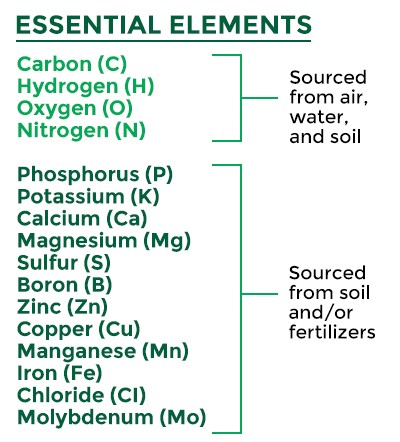Know Your Nutrients: 16 Essential Elements
Like humans, plants require certain key nutrients to grow well, develop, reproduce and remain healthy. The performance of a crop in the field depends on the genetic makeup of the variety grown, fertility and pesticides programs, and interaction with the environment.
The elements required by plants and obtained from soil and/or fertilizers encompass major nutrients (aka macronutrients), secondary nutrients, and micronutrients (aka trace elements). The qualification of major and minor nutrients comes from the relative abundance and requirement for various functions in plants.

The essential elements required to grow a crop and their sources.
Plants also need or accumulate Sodium (Na), Silicon (Si), Cobalt (Co), Nickel (Ni), Iodine (I) and Selenium (Se). These are not always necessary for their survival but important for humans and animals that depend on plants for their diet.
THE ROLE OF THE ESSENTIAL ELEMENTS
PRIMARY (MACRO) NUTRIENTS
Nitrogen (N), Phosphorus (P), and Potassium (K) are the most frequently required in a crop fertilization program.
- Nitrogen is necessary for the formation of amino acids, proteins, DNA and RNA. It is essential for plant cell division and vital for plant growth.
- Phosphorus promotes early root formation and growth, and is involved in photosynthesis, respiration, energy storage and transfer, cell division and enlargement.
- Potassium is involved in carbohydrate metabolism and the break down and translocation of starch. Potassium also enhances disease resistance and improves winter hardiness.
SECONDARY NUTRIENTS
Calcium (Ca), Magnesium (Mg), and Sulfur (S) are required in lesser amounts than macronutrients, but each is equally important to the crop.
- Calcium increases fruit set and quality and is important for continuous cell division and formation (regulates hormonal activity).
- Magnesium, the center molecule of chlorophyll, improves utilization and mobility of phosphorus.
- Sulfur is an integral part of amino acids. It helps develop enzymes, vitamins and oil contents, and aids in seed formation.
MICRONUTRIENTS
Boron (B), Zinc (Zn), Copper (Cu), Manganese (Mn), Iron (Fe), Chloride(CI) and Molybdenum (Mo) are used in minute amounts but are just as important to plant growth and development as the major nutrients. Some micronutrients control the uptake of major nutrients and key processes.
- Boron is an essential component of cell wall formation and is key for the germination of pollen grains and growth of pollen tubes.
- Zinc aids plant growth hormones and enzyme system and is necessary for chlorophyll production and carbohydrate formation.
- Copper plays a major role in photosynthesis. This element improves the flavour of fruits and vegetables and can help prevent ergot in cereals.
- Manganese aids in chlorophyll synthesis and increases the availability of phosphorus and calcium.
- Iron promotes the formation of chlorophyll and acts as an oxygen carrier.
- Chloride promotes crop health and enhances the maturity of small grains on some soils.
- Molybdenum is needed to convert inorganic phosphates to organic forms in the plant and aids in the nodulation of legumes, especially in acidic soils.
These are just a few of the ways that essential elements contribute to crop health. For the next several weeks, we will be dissecting these elements one at time, addressing how they can be managed properly and used in balance with other nutrients to promote growth and development and preserve yield and quality.
In our next post, we will take an in-depth look at the vital role nitrogen plays in plant health.
